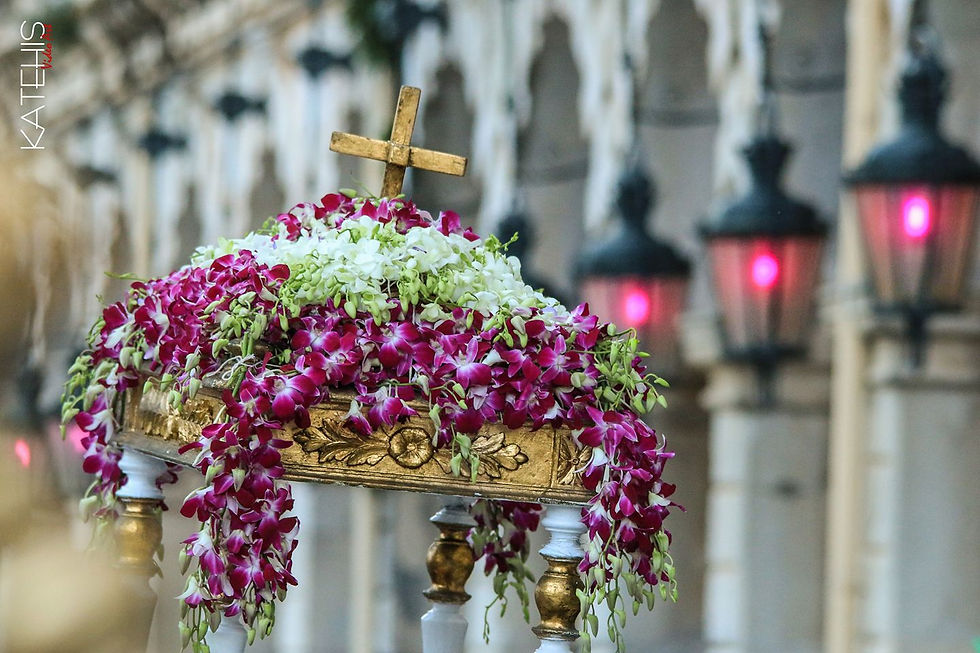Easter in Corfu is certainly a unique experience nowhere to be found anywhere else in Greece
- Giwrgos Pnds

- 11 Απρ 2022
- διαβάστηκε 5 λεπτά
Έγινε ενημέρωση: 13 Απρ 2022

Easter time in Corfu Island is an experience worthy to live! During the Easter time in Corfu, a period that the locals call it “Lambri”, meaning brightness, is where the festivities and the religious/psychological brightness create that unique feeling.
Considered the ultimate Hellenic celebration, Easter in Corfu town is without a doubt a spectacular event. Thousands of visitors gather each year to be part of this joyous, unique and spectacular experience.
Easter Celebrations In Corfu Town
Easter in Corfu is one of the bigger festivals of the Orthodox church, with celebrations found nowhere else, so it is the perfect excuse to visit Corfu during springtime. Celebrations last for a week
Celebrations always start a week before Easter and they go like that:
Palm Sunday
You will have the chance to witness a custom that is dating back to 1630. All 15 philarmonic bands of the island take part in the procession of the holy body of Saint Spyridon, the protector of Corfu Island, who it is believed relieved the whole island from Plague in 1629. Then you can have lunch and enjoy the traditional meal of the day: codfish with garlic-flavored mashed potatoes.
Great Monday and Tuesday
If you walk among the alleys of the old town of Corfu you will smell the perfume of “fogatsa” (a brioche decorated with a red egg) and “mandolato” (a noble’s favorite macaroon made of almond and honey), which we undoubtedly recommend getting a taste of. If you happen to stroll in the city on the afternoon of Tuesday you will get the chance to listen to the story of Mary Magdalene “hymned” at the city churches.
Great Wednesday
During Wednesday the Holy Unction is sung by all the city’s churches and the Municipal Choir gives its own color with a concert at the Municipal Theatre. You will hear ecclesiastical hymns of the Passion Week with chorals from the East and the West.
Maundy Thursday
"Today is the day where people paint the eggs"
The Service of the Holy Passion is attended by the Corfiots in the churches. In the Duomo, the Catholic Cathedral something different takes place. 12 different candles are lit and after the reading of each of the 12 Gospels, one by one is put out. On the same day, the first bell ring signals the time for the eggs to be dyed in the color red and the arrival of a day of mourning.
Great Friday
On Friday, the churches are filled with people before noon to take part in the ceremony of the Descent of Christ from the Cross and the circumambulation of the dead Christ on a white sheet. It is practically a funeral, so it is an emotional ceremony. Later, the children run on the neighborhoods to ask people for flowers to decorate the Epitaph. Each church has its own Epitaph and is decorated by young girls.

*The churches are taking care of the Epitaphs preparation, decorated with beautiful flowers.
33 Epitaphs, representing the age of Jesus, are processed around Corfu Town, which finally gathers at the center of the Town.
Credit Photo : Spyros Katehis
Towards noon the faithful gather to the church for Epitaph pilgrimage. After that, the circumambulation of the Epitaphs on the streets alleys and squares of the old city and the suburbs starts. From the afternoon until late at night, Epitaphs will pass around the city and they will gather at the historic center. At the Epitaph processions take part schools, scouts and groups of little girls carrying baskets full of flowers. Late in the night, the procession of the last and the most impressive Epitaph of Corfu Cathedral starts.
All the authorities, priests, locals and visitors participate in giving another dimension to this mournful night. The Old Philarmonic (red) plays the “Adagio” by Albinoni, the Mantzaros Philarmonic (blue) plays the “Marcia Funebre” by Verdi and Kapodistrias Philarmonic (red) plays “Sventura” by Mariani.
Holy Saturday
Good Saturday: On Good Saturday, basically begin the Easter celebrations. During the morning hours, approximately at 06:00 am, a ritual is taking place in Saint Spyridon. They create an artificial earthquake to represent the resurrection, as described in the Holy Bible.
At 9:00 am, the procession of Saint Spyridon relics and the epitaph begins, accompanied by three philharmonics, the “Old”, “Kapodistrias”, and “Mantzaros”, and one of the oldest epitaph processions in Corfu, exceptionally processed on that day, since the epitaph processions are a tradition to take place on Good Friday.
At 11:00 am, the “First Resurrection” takes place inside the churches, and the bells of the churches ring cheerfully, and the popular “Botides” custom takes place in Corfu Town
“Botides” custom refers to the time when people are throwing big clay pots filled with water from their balconies, and the crowd is watching, and the philharmonics play religious marches.
The origin of this custom derives from the Venetian occupation, where people used to throw the old stuff from their balconies during New Year’s Eve, hoping that the New Year brings them happiness and new things. In the Old Town of Corfu, another custom takes place, “Mastella” where a big barrel full of water is placed by the road, and all people passing by should throw a coin in the barrel.

*Red clay pots are caught in mid-air as they are thrown to the streets. A symbolic ritual re-enacting the Earthquake after Christ’s Resurrection.
Credit Photo : Stamatis Katapodis



























Σχόλια